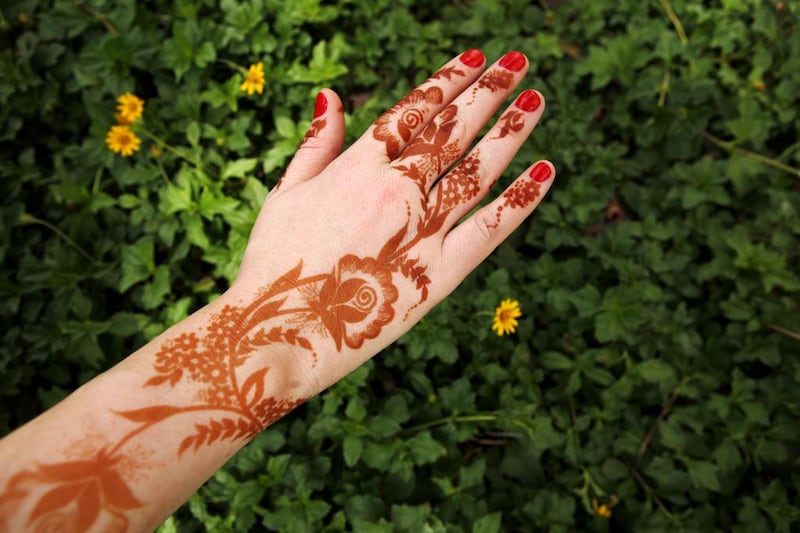It is 2pm, and the woman sits with a phone in her hand, a bored look on her face.
Her arms and legs heavily decorated with intricate henna designs, she is unable to move. A small heater whirrs at her legs, drying the paste until it turns from moss brown to black.
It is a familiar sight in an Abu Dhabi beauty salon, and especially so in the run-up to Eid.
Amid a sea of phones pressed to customers’ faces, staff studiously apply henna, their concentration interrupted every few minutes by someone calling, hoping for an appointment.
Mehndi, or henna dye comes from the Lawsonia inermis, a flowering plant sometimes known as the Egyptian privet, but also referred to as “the henna tree”.
From its use, as an art form in Asia, to being used as a hair dye in Ancient Egypt, today its use is synonymous with religious and cultural festivals in the Middle East and South Asia.
The plant is also claimed to have healing properties, its bark and seeds are used in Ayurvedic and Unani medicines, and fans say it makes their skin softer.
The origins of its popularity in the UAE may have had more to do with vanity than anything else, says Prof Hamad bin Seray, of UAE University’s history and archaeology department.
“A long time ago, it was a kind of make-up. They used it to be put on during Eid and also other celebrations, like weddings.”
Designs, too, were simpler, Prof bin Seray says. “Before, they put it on just in one way. But now, we have different things. Years ago, there was only one way. It is very complicated now.”
An exhibition of 45 sheets of paper hang in plastic pockets, showcasing the range of designs on the back wall of the beauty salon.
The floral patters are influenced by the Arab world, one staff member says. Lattice designs and finer detail, she adds, take their cue from Indian culture.
At midnight, the salon is still full; the phone, still ringing. The tang of the paste fills the room.
Staff flit between customers, creating patterns at the flick of a wrist, the speed with which they work having no effect on the quality of the designs. Some take snapshots on their mobiles of the patterns on the wall, keeping the pictures within view so as not to make a mistake.
The Disney film Frozen starts to play in the background, though it is anything but in the chaos of the salon, the heaters dotted around creating a stifling atmosphere.
“This is my least favourite Disney movie,” one lady sighs, as she removes the dried henna from her hands with a table knife.
Children sit by their mothers, twiddling their newly decorated toes. Nearby, a woman closely inspects the flowers on her left foot, nodding with satisfaction. The flowers on the right, she says to the lady applying her henna, need more detail.
The fuss, Dubai resident Saeeda says, is worth it.
“I think no festival is complete without henna. It’s very traditional. As far back as I can remember, we’ve never missed out on henna, particularly on a festival.”
Although the trend seems to lean towards more intricate designs, the Indian expatriate says it does not take away from the beauty of the practice.
“These days, it is very decorative. I remember my mother used to get some blobs and make a flower out of them and they used to be so beautiful.
“We would wait late into the night after she finished all her work. We would patiently wait for her to apply it for us.”
For Saeeda, the intricacy of the designs she chooses depend on the occasion. For a wedding, a highly detailed tattoo is desirable. “Ideally, I would like something simple yet decorative. And a good colour.”
Once the henna crumbles off, a coppery, some say dark amber, colour remains. A daily application of olive oil, a salon employee says, will prolong the time it takes for the pattern to start fading.
White henna is also available at some salons, although black is banned in the UAE.
Containing the dye para-phenylenediamine, which gives the paste its black tint, it can cause blistering, scarring and life-threatening health issues if someone has an allergic reaction to it.
A few nights before Eid, Saeeda will have henna applied, most likely, on her hands. “Henna is a very, very important part of our tradition,” she says.
Back in the salon it is 2am, and the phone is still ringing. One of the ladies helping passes out takeaways that have been delivered to customers as they bide their time, some impatiently, waiting for the henna to dry. Another calls a friend who comes quickly, laden with snacks.
A would-be customer, unhappy with the queue, bemoans her situation to a staff member, asking when the salon will reopen.
“7am,” she says incredulously. “Do they [the staff] not sleep?”
Not much, admits one of the ladies, as she delicately applies paste to an arm.
Over the past few days, she has slept only a handful of hours a night, the demand for henna tattoos taking precedence.
When Eid comes, she says with a smile, she knows what she will be doing. “Sleeping,” she laughs, as she completes a customer’s order and prepares for the next request.
It is 2.30am, and, in the salon that never sleeps, the phone is still ringing.
Zaineb Al Hassani is a senior news editor at The National.
zalhassani@thenational.ae





